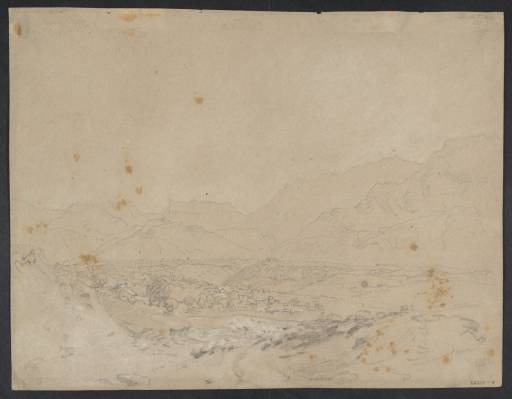This is a drawing on buff-coloured laid paper. A thick, soft graphite pencil has been used in the foreground to create dark, soft looking areas. A finer, harder graphite pencil has been used in the background to create a sense of depth and distance. Turner habitually employed two hardnesses of pencil to achieve such effects.
Here he applied very light touches of white gouache in the foreground, over the pencil shading. This narrow range of materials was a highly practical choice when travelling far from home and working outdoors. The several brown stains on the image, probably picked up long afterwards in Turner’s studio, dominate the image and reduce the impact of the gouache highlights.
The top edge of the sheet has been roughly cut and there are three small nicks and one small hole where this side was bound into a sketchbook. In the past this image was covered with a window mount and displayed in bright light for a prolonged period of time, which has caused slight but irreversible darkening of the paper.
Helen Evans
October 2008
Revised by Joyce Townsend
February 2011
How to cite
Helen Evans, 'Technique and Condition', October 2008, revised by Joyce Townsend, February 2011, in David Blayney Brown, ‘Near Aosta 1802 by Joseph Mallord William Turner’, catalogue entry, September 2011, in David Blayney Brown (ed.), J.M.W. Turner: Sketchbooks, Drawings and Watercolours, Tate Research Publication, August 2014, https://www.tate.org.uk/art/research-publications/jmw-turner/joseph-mallord-william-turner-near-aosta-r1146370, accessed 02 April 2025.

